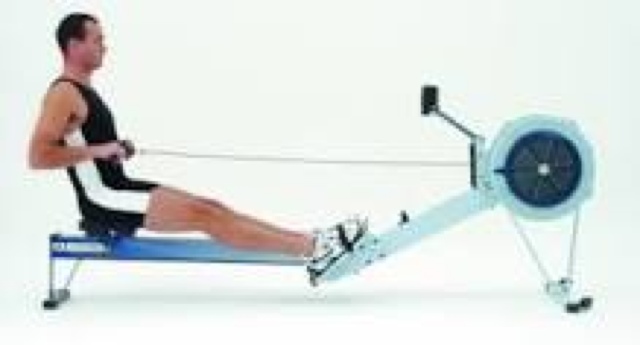The Basics:
Head up as to not stress the neck.
Hands over the grip, not under.
Brunt of grip should be grabbed with first crevice in the fingers, NOT where the fingers meet the palm.
Place thumb wherever comfortable.
There are four steps: The Catch, the Drive, the Finish, and the Recovery.
The Catch:
The first step. Knees should be perpendicular to ground, or slightly less than perpendicular. Arms fully extended, don't roll shoulders or back. Core up, should be leaning forward, but not resting on knees. Grip should be as close to the neck of the machine as possible.
The Drive:
Where the power comes from. Pushing off with the balls of your feet, drive first with legs, then back, then finally arms. Should be natural. Goal is to extend legs as quickly as possible, and keep height of grip as consistent as possible (about chest height).
The Finish:
Keeping wrists flat, bring handle to chest, then lower slightly. Keep back straight, ideally bent back as far as possible without affecting balance.
The Recovery:
The resting portion, do it in reverse of the drive. First extend arms forward, then bring body towards front, then bend legs. Return to catch and repeat motions.
Final Tips:
No jerking motions, it should be fluid.
Erging, while incredibly tiring and a great exercise for the back, lower back, and legs, has almost no impact. It's very very very difficult to suffer physical damage from erging.
To find out sprinting time, row 2,000 meters nonstop at a 29-31 strokes per minute pace. Sprinting time (500m>) is a 30-32 strokes per minute pace with a 500m split approximately five seconds lower than 2k 500m split.
500-1000m pieces are at about 2 seconds faster than 2k time per 500 meters.
1000-2000m pieces should be done at 2k pace.
I personally don't prefer longer pieces, because I prefer interval training due to the sports I play, but if you play soccer, are a distance runner, triathlete, etc, long pieces are great for increasing endurance while limiting impact. The typical long distance pieces are either 6k, 10k, or measured by time. Long distance pieces should be performed within the aerobic system at about a 23-26 strokes per minute pace. The split for a 6k and 10k will be similar. The difference in 500m split for a 2k and a longer distance piece should be about 6-8 seconds.




No comments:
Post a Comment